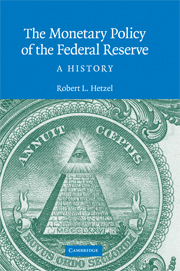Book contents
- Frontmatter
- Contents
- Figures
- Preface
- 1 The Pragmatic Evolution of the Monetary Standard
- 2 Learning and Policy Ambiguity
- 3 From Gold to Fiat Money
- 4 From World War II to the Accord
- 5 Martin and Lean-against-the-Wind
- 6 Inflation Is a Nonmonetary Phenomenon
- 7 The Start of the Great Inflation
- 8 Arthur Burns and Richard Nixon
- 9 Bretton Woods
- 10 Policy in the Ford Administration
- 11 Carter, Burns, and Miller
- 12 The Political Economy of Inflation
- 13 The Volcker Disinflation
- 14 Monetary Policy after the Disinflation
- 15 Greenspan's Move to Price Stability
- 16 International Bailouts and Moral Hazard
- 17 Monetary Policy Becomes Expansionary
- 18 Departing from the Standard Procedures
- 19 Boom and Bust: 1997 to 2001
- 20 Backing Off from Price Stability
- 21 The Volcker–Greenspan Regime
- 22 The Fed: Inflation Fighter or Inflation Creator?
- 23 The Stop–Go Laboratory
- 24 Stop–Go and Interest Rate Inertia
- 25 Monetary Nonneutrality in the Stop–Go Era
- 26 A Century of Monetary Experiments
- Appendix: Data Seen by FOMC for the Stop–Go Period Shown in Figures 24.1, 24.2, and 24.3
- Notes
- Bibliography
- Index
- Titles in the series
24 - Stop–Go and Interest Rate Inertia
Published online by Cambridge University Press: 26 May 2010
- Frontmatter
- Contents
- Figures
- Preface
- 1 The Pragmatic Evolution of the Monetary Standard
- 2 Learning and Policy Ambiguity
- 3 From Gold to Fiat Money
- 4 From World War II to the Accord
- 5 Martin and Lean-against-the-Wind
- 6 Inflation Is a Nonmonetary Phenomenon
- 7 The Start of the Great Inflation
- 8 Arthur Burns and Richard Nixon
- 9 Bretton Woods
- 10 Policy in the Ford Administration
- 11 Carter, Burns, and Miller
- 12 The Political Economy of Inflation
- 13 The Volcker Disinflation
- 14 Monetary Policy after the Disinflation
- 15 Greenspan's Move to Price Stability
- 16 International Bailouts and Moral Hazard
- 17 Monetary Policy Becomes Expansionary
- 18 Departing from the Standard Procedures
- 19 Boom and Bust: 1997 to 2001
- 20 Backing Off from Price Stability
- 21 The Volcker–Greenspan Regime
- 22 The Fed: Inflation Fighter or Inflation Creator?
- 23 The Stop–Go Laboratory
- 24 Stop–Go and Interest Rate Inertia
- 25 Monetary Nonneutrality in the Stop–Go Era
- 26 A Century of Monetary Experiments
- Appendix: Data Seen by FOMC for the Stop–Go Period Shown in Figures 24.1, 24.2, and 24.3
- Notes
- Bibliography
- Index
- Titles in the series
Summary
The Great Inflation stretched from 1965 through 1981. No one has provided a comprehensive empirical characterization of the go–stop character of policy in this period, which included four cycles of expansionary and contractionary policy. The characterization here highlights the monetary accelerations and decelerations that accompanied cyclical interest rate smoothing and the temporal antecedence of money with respect to inflation.
According to Taylor (1999), inflation appeared and then policy became expansionary because the FOMC raised the funds rate only timidly. In fact, monetary policy became expansionary and then inflation rose. As documented in the Appendix, “A Taxonomy of Stop–Go,” in this period, funds rate inertia is more aptly characterized as occurring relative to changes in nominal output growth rather than relative to changes in inflation. Finally, characterizations of monetary policy that omit money inadequately summarize the temporal relationships between variables produced by monetary shocks.
The following summarizes the empirical regularities of this period for economists who want to test models with monetary shocks. Figures 24.1 through 24.3 plot data available to the FOMC at its meetings. (Data are in Appendix: Data Seen by FOMC for Stop–Go Period.) The data continue on Figures 24.1A through 24.3A, which use a larger scale because of the increased volatility in the early Volcker period. I divide the graphs into four cycles of go–stop policy with three phases in each cycle. One should examine the four phase 1 intervals across the three graphs and then the phase 1a intervals and finally the phase 2 intervals.
- Type
- Chapter
- Information
- The Monetary Policy of the Federal ReserveA History, pp. 287 - 302Publisher: Cambridge University PressPrint publication year: 2008

